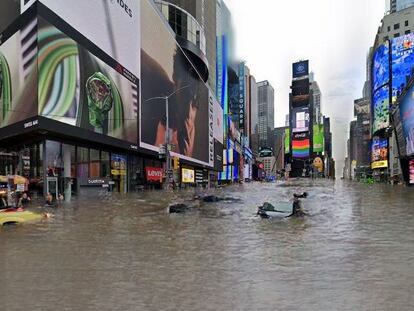Extreme heat is the new normal for the world’s oceans, according to study
According to the research, more than half of the planet’s marine surface is suffering from temperature rises, which is pushing many species to migrate further north
In the 120 months that formed the decade from 2010 to 2019, the waters that bathe the coasts of the Maldives in the Indian Ocean recorded extreme temperatures in 111 of them. A century ago, this would only happen on a few days each year. The phenomenon is not limited to this area of the planet; the warming of the seas and oceans is as global a problem as it is on dry land. Analysis of temperatures from 150 years ago to today shows that what in the past was a rare extreme thermal event is now the norm. The impact on plant and animal life in the oceans is already being felt, with more and more species migrating further north, or further into the cooler deep.
The first time that thermal extremes became normal in a specific part of the seas was in 1998, in the South Atlantic. This point of no return was defined by the authors of the study as the year in which more than half a given area reaches and maintains the average maximum temperature recorded in the first 50 years of the study (from 1870 to 1919). The Indian Ocean reached this threshold in 2007. In 2014, half of the entire marine surface of the planet was weathering these heatwaves. Now, the investigation, titled The recent normalization of historical marine heat extremes and published in specialist scientific journal PLOS Climate states that in 2019, 57% of the Earth’s ocean surface reached and maintained what the researchers describe as extreme marine heat events.
The study covers historic temperature records of every sea and ocean on the planet from 1870. Using this data, obtained from institutions such as the British Meteorological Office, the researchers drew up an index of average monthly extreme temperatures since 1919. Then they compared the data from that index with those observed in recent decades. What they found was that today, more than two-thirds of the marine surface of the Earth is affected by extreme temperatures, compared to just 2% historically.
Kyle Van Houtan, director of the Loggerhead Marinelife Center in Florida, co-authored the study while he was Chief Scientist at the Monterey Bay Aquarium. In his view, “climate change is not something that’s going to happen in the future; the reality is it has been affecting us for some time already.” Both the temporal and spatial increase in maximum temperatures in some areas, such as the territorial waters of Indian Ocean nations like the Maldives and Tanzania, means that “in these areas, heat extremes have increased up to 47 times,” says Van Houtan.
The large sea basins where the increase in extreme temperatures has been most pronounced are, as well as the Indian Ocean; the central Atlantic region, the part of the Pacific closest to Asia and the polar oceans, while the areas where the sea surface has best managed to maintain its historical averages are the American Pacific, particularly the southern section, and the North Atlantic. However, it seems there are no areas of oceans where temperatures have dropped. “We haven’t analyzed the occurrence of extreme cold, but it would be easy enough to do so,” says Van Houtan via email. “According to the results of this study, where we have shown that extreme heat is increasing and has become commonplace, we believe that extreme cold temperatures in the oceans have decreased significantly.”
Climate change is not something that’s going to happen in the future; the reality is it has been affecting us for some time alreadyKyle Van Houtan, director of the Loggerhead Marinelife Center in Florida
Although it is not the primary objective of the study, its authors also mention the possible causes behind the warming of the oceans, which have been highlighted by recent reports by the United Nations Intergovernmental Panel on Climate Change. One such cause is the flow of warm air from the Earth’s atmosphere, which is increasingly heating up due to the concentration of greenhouse gases. Another is an increase in the frequency, duration and intensity of heatwaves. In a 2018 work, the authors estimated that the frequency of these periods of several days of extreme heat had increased by 34% over the past century, their duration by 17% and, in total, the number of days when temperatures exceed the extreme average had increased by 54% since the beginning of the 20th century.
This “new normal” is creating a series of changes in the marine environment that the scientific world has been highlighting for several years. In the same way that global warming is causing many land-based species to emigrate to cooler latitudes, in the oceans, a larger number of fish are doing the same and heading further north. José Luis Sánchez, professor of Marine Sciences and Applied Biology at the University of Alicante, published a study in 2017 on the main species of tuna in the Atlantic, Indian and Pacific Oceans. Since 1965, catches of sub-tropical species have been increasing further and further north, showing a link between temperature increases on the sea surface and migration.
“They are spreading to higher latitudes and this is happening across all of the oceans,” says Sánchez, adding that the changes “are occurring at all levels, not just with tuna and other fish species but also phytoplankton and zooplankton.” The other great migration is taking place vertically, with many species seeking cooler temperatures in the ocean deep.
But these migrations have their limits. For example, species that depend on photosynthesis cannot descend in the water column. Furthermore, cold-water species cannot extend far beyond the Arctic and Antarctic Oceans. But the issue is most pronounced in tropical waters. As Sánchez notes: “The warmer areas are emptying of species.”
Tu suscripción se está usando en otro dispositivo
¿Quieres añadir otro usuario a tu suscripción?
Si continúas leyendo en este dispositivo, no se podrá leer en el otro.
FlechaTu suscripción se está usando en otro dispositivo y solo puedes acceder a EL PAÍS desde un dispositivo a la vez.
Si quieres compartir tu cuenta, cambia tu suscripción a la modalidad Premium, así podrás añadir otro usuario. Cada uno accederá con su propia cuenta de email, lo que os permitirá personalizar vuestra experiencia en EL PAÍS.
¿Tienes una suscripción de empresa? Accede aquí para contratar más cuentas.
En el caso de no saber quién está usando tu cuenta, te recomendamos cambiar tu contraseña aquí.
Si decides continuar compartiendo tu cuenta, este mensaje se mostrará en tu dispositivo y en el de la otra persona que está usando tu cuenta de forma indefinida, afectando a tu experiencia de lectura. Puedes consultar aquí los términos y condiciones de la suscripción digital.
More information
Últimas noticias
Reinhard Genzel, Nobel laureate in physics: ‘One-minute videos will never give you the truth’
Pinochet’s victims grapple with José Antonio Kast’s rise in Chile
How Japan is trying to avert ‘digital defeat’
The complicated life of Francesca Albanese: A rising figure in Italy but barred from every bank by Trump’s sanctions
Most viewed
- Pablo Escobar’s hippos: A serious environmental problem, 40 years on
- Why we lost the habit of sleeping in two segments and how that changed our sense of time
- Charles Dubouloz, mountaineering star, retires at 36 with a farewell tour inspired by Walter Bonatti
- Trump’s obsession with putting his name on everything is unprecedented in the United States
- The Florida Keys tourist paradise is besieged by immigration agents: ‘We’ve never seen anything like this’











































